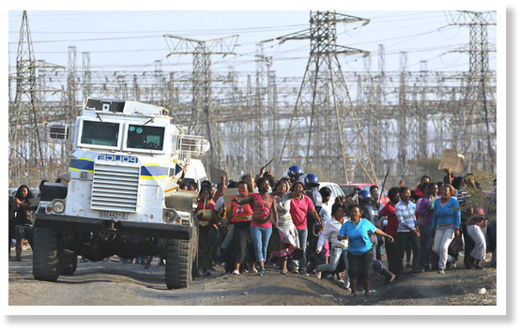
The commissioner, Riah Phiyega, described a desperate struggle by the police to contain the machete-wielding crowd of thousands of angry miners who broke through two lines of defense, leaving officers with no choice but to open fire with live ammunition.
"The militant group stormed toward the police firing shots and wielding dangerous weapons," Ms. Phiyega said at an emotional news conference here, using an extensive array of aerial photographs and video to demonstrate how the violence unfolded. Previous attempts by the 500-strong police force to repel the crowd with rubber bullets, water cannons and stun grenades had failed, she said.
"This is no time for finger-pointing," Ms. Phiyega said. "It is a time for us to mourn the sad and dark moment we experienced as a country."
It was South Africa's worst labor-related violence since 1994. The shootings stunned the nation: front pages of newspapers were plastered with pictures of dead miners lying in a field above headlines like "Bloodbath" and "Killing Fields."
President Jacob Zuma cut short his trip to neighboring Mozambique for a regional summit meeting to rush to the site of the bloody protest, 60 miles northwest of Johannesburg.
"These events are not what we want to see or what we want to become accustomed to in a democracy that is bound by rule of law," Mr. Zuma said in prepared remarks. He announced the formation of a commission of inquiry to investigate the illegal strike and the response of the police.
The police retrieved six guns from the protesters, including one that had been taken from a police officer who was hacked to death by the workers earlier in the week, Ms. Phiyega said, as well as many machetes, cudgels and spears.
Miners who escaped the melee gave a very different account of what happened when the police closed in on the rocky outcropping they had occupied. A 36-year-old mine employee named Paulos was among the striking workers on Thursday when the police began encircling the rocky hill with razor wire.
"They started shooting at us with rubber bullets," Paulos said. "Then I saw people were falling and dying for real. I knew then they were proper bullets."
He struggled to understand why the police had opened fire with live rounds.
"I never thought this would happen," he said. "We thought the police were there to protect us."
Women who said they were wives of missing miners gathered at the site of the protest, waving wooden sticks and singing protest songs.
"I don't know where my husband is, whether he is in jail, among the dead or the injured," said a woman named Mbalenhle who declined to give her last name. "Our husbands were only fighting for their rights, but the police are killing them."
The shootout followed a tense week of protests by workers at the platinum mine, owned by Lonmin, a London company. The miners walked off the job last Friday, demanding that their wages be tripled.
The striking workers are members of a radical labor union that splintered off from the National Union of Mineworkers, one of the country's biggest and oldest unions.
The splinter group claims that the older union, which is closely allied to the African National Congress, is too cozy with big business and the political elite.
Frans Baleni, general secretary of the National Union of Mineworkers, rejected that notion and said the rival union, the Association of Mine Workers and Construction Union, was giving people false hope, with tragic consequences.
"You have opportunists who are abusing ignorant workers," Mr. Baleni said. "We saw the results yesterday."



Reader Comments
to our Newsletter